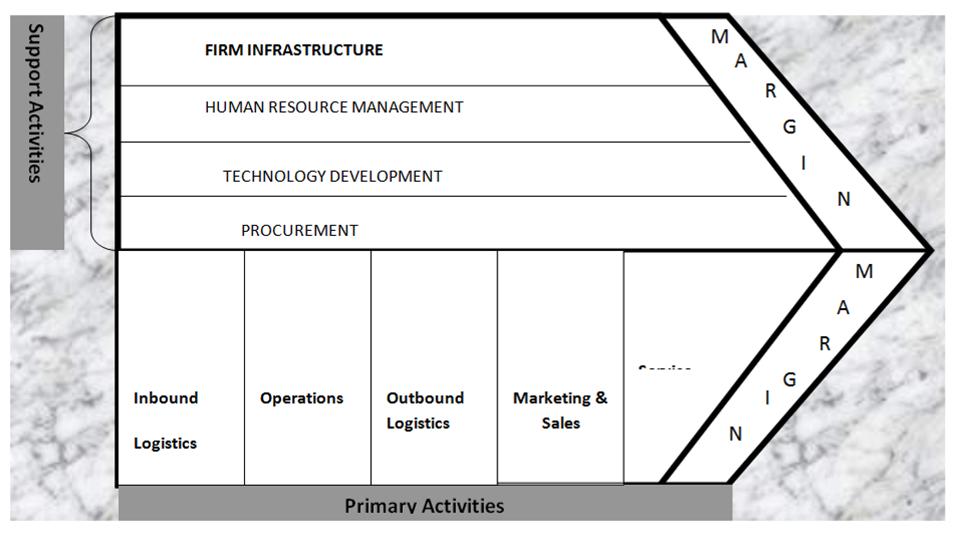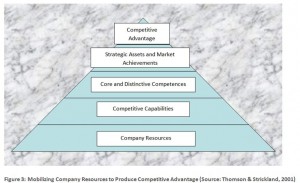Christos Ioannou, CMA, ask the very salient question, “Does Resourced-Based Sources (RBS) have any interconnection to the concept of competitive advantage?” In this article specifically written for On Target, he focuses on the theory of the RBS approach and highlights the key elements leading to competitive advantage.
What constitutes a “resource”?
According Daft (1983), “Firm resources include all assets, capabilities, organizational processes, firm attributes, information, and knowledge”. Resources can be characterized as the blood of organization. Without blood nothing can be organized and executed for the benefit of organization.
What constitute “capability”?
According to Makadok (2001), the distinction between capabilities and resources are “special type of resources, specifically an organizationally embedded non-transferable firm-specific resource…” which the main scope is to improve the efficiency and productivity of the other interconnected resources of the firm.
The interconnection of resources and capabilities are the two inseparable key elements for the success of every organization. Resources can be defined the stocks, money, machinery, technology, and the intellectual capital. Resources can be separated into tangible and intangible categories. Consequently, the key to success of an organization is to be able to use its resources efficiently and effectively in order to meet its strategic goals. The interconnection of resources and capabilities ability can benefit organizations.
What constitutes “competitive advantage”?
According to Barney (1986b), competitive advantage can be attained if the current strategy is value-creating. Consequently, in order for something to be value creating means that the competitive advantage cannot be imitated by existing competitors. The competitive advantage is the outcome of effective and efficient strategy, which is not an easy task for organizations because in the era of fast changing environment competition is very strong. The strategic scope of every organization is to gain the competitive advantage over competitors. Thus, the source of competitive advantage cannot be imitated by competitors in the future. Competitive advantage can be gained from adoption of advance technology, excellent service, low cost production, or selling of unique products. However, hyper-competition might eliminate this advantage and as a result systematic and continuous efforts may prove to be ineffective.
What is a Resourced-Based View?
Wernefelt (1984) stated that the Resource-Based View (RBV) of a firm is a business management tool used to determine the strategic resources available to a company. The significance and value of RBV depend on strategic managers. As a strategic management tool, RBV depends on how well the strategic managers will assess the company’s resources. The effective assessment will lead to the adoption of effective strategic plan. Efficient and effective utilization of strategic resources will lead to competitive advantage of the company.
What is the Value-Chain?
Porter (1985) stated, “Every firm is a collection of activities that are performed to design, produce, market, deliver, and support its products”. He stated very effectively the cohesion of primary and support activities of an organization emphasizing that the scope of every organization is to survive in the long-term horizon.
Consequently, the responsibility of every organization is to maximize its profits. The role of every activity is to contribute to the profitability of the company. Every activity of the company has to play its significant role to the success of an organization. For example, the role of primary activities such as logistics, marketing, and sales and the after sale services are very crucial for every organization. Thus, the successful activities performed to design, produce, market, deliver, and support the company’s products will contribute to the gaining of competitive advantage. Porter (1985) represented primary and support activities using a value chain model (Figure 1).
In addition to the primary activities described by Porter (1985), procurement, technology development, human resource management, and firm’s infrastructure can lead to the gaining of competitive advantage. Activities can include the efficient utilization of ERP system, good organization of accounting and finance departments, effective human resource management strategy (e.g., training and development of staff), introduction of quality management systems and approaches such as ISOs and HACCPs. Kotler (2000) has a similar view stating that the success of the firm is a combination of effective management and co-ordination of organizational business units.
 Figure 1: The Generic Value Chain (Source: Porter, 1985)
Figure 1: The Generic Value Chain (Source: Porter, 1985)
What are the Resource-Based Sources of Competitive Advantage?
Johnson, Scholes, and Whittington (2008) stated, “The resourced-based view of strategy: the competitive advantage and superior performance of an organization is explained by the distinctiveness of its capabilities”. Johnson et al. (2008) depicted the interconnection of competitive advantage to unique resources and core competencies (Figure 2).
| Resources | Competencies | |
| Threshold Capabilities | Threshold resourcesTangibleIntangible | Threshold competencies |
| Capabilities for Competitive Advantage | Unique resourcesTangibleIntangible | Core competencies |
Figure 2: Strategic Capabilities And Competitive Advantage (Source: Johnson, Scholes, & Whittington, 2008)
To understand Figure 2, the following terminologies are very crucial:
Strategic capability: Strategic capability is the resources and competences of an organization. These are crucial inseparable parts of every organizational success
Unique resources: These are the unique resources that are interconnected element of competitive advantage, especially because cannot be duplicated or imitated by competitors.
Core competencies: Core competencies are activities that are interconnected to competitive advantage and furthermore cannot be duplicated or imitated by competitors.
The key to success of every organization is the achievement to deploy unique tangible and intangible resources, which cannot be imitated by their rival competitors. The significance of these and interconnection of core competencies is seen as an inseparable item into the process of competitive advantage.
The pyramid model shown in Figure 3 was developed by Thomson and Strickland (2001) and illustrates the steps necessary for an organization to plan and execute in order to arrive to the top of the pyramid. Companies should address the cohesion of every step shown in Figure 3. Possible weaknesses between in any of the above elements mean inefficiency and loss of competitive advantage. The basis of competitive advantage is the company’s resources. Achievement of competitive advantage consists of four interconnected and inseparable steps.
References
Barney, J.B., (1986). Organizational Culture: Can It be a Source of Sustained Competitive Advantage? Academy of Management Review; 11(3), pp. 656–665
Daft, L.R., (1983). Organizational Theory and Designs, West Pub. Co. , St. Paul. Cited in Wikipedia, http://en.wikipedia.org/wiki/Resource-based_view. (Accessed date: 11th October 2010).
Johnson, G., Scholes, K. and Whittington, R. (2008). Exploring Corporate Strategy – Text & Cases, 8th Edition, Prentice Hall, pp. 94.
Kotler, P. (2000). Marketing Management: International Edition, The Millennium Edition, p. 45.
Makadok, R. (2001). Toward a Synthesis of the Resource-Based View and Dynamic-Capability Views of Rent Creation. Strategic Management Journal; 22, (5), pp. 387–401. Cited in Wikipedia, http://en.wikipedia.org/wiki/Resource-based_view. (Accessed date: 11th October 2010).
Porter, M., (1985). Competitive Advantage: Creating and Sustaining Superior Performance with new introduction, pp. 34-43.
Thomson, A. & Strickland, A. (2001). Crafting and Executing Strategy Text and Readings, Twelfth Edition, p. 119.
Wernerfelt, B. (1984). The Resource-Based View of the Firm. Strategic Management Journal; 5, (2), pp. 171–180. Cited in Wikipedia, http://en.wikipedia.org/wiki/Resource-based_view. (Accessed date: 10th October 2010).
Christos Ioannou BA (Hons), MBA (Fin.), CMA, C.Mgr, is a Business & Management Consultant. He is the Representative of the ICMA Cyprus Division. He can be contacted at [email protected]


